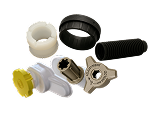The automotive industry is undergoing a significant transformation in 2025, and at the heart of this evolution lies innovation in plastic parts manufacturing. As vehicle design becomes more performance-driven and sustainable, the role of high-quality plastic components in both interior and exterior applications has grown immensely. From bumpers and grilles to dashboards and center consoles, plastic parts are essential in modern automotive engineering.
The Rise of Lightweight Materials
Weight reduction continues to be a top priority for automotive manufacturers. Interior and exterior plastic parts offer a key advantage: they are significantly lighter than traditional metal components while maintaining strength and durability. This leads to improved fuel efficiency in combustion vehicles and better range performance in electric vehicles (EVs).
Automotive-grade plastics such as ABS (Acrylonitrile Butadiene Styrene), polypropylene, polycarbonate, and advanced composites are now widely used for manufacturing everything from door panels to engine covers. These materials not only reduce vehicle weight but also enhance crash safety and corrosion resistance.
Keywords: lightweight plastic parts, fuel efficiency, automotive-grade plastics, polypropylene car parts
Advanced Manufacturing Techniques
Modern automotive plastic parts manufacturers are moving beyond conventional processes. Injection molding remains a core technique due to its cost efficiency and precision. However, 2025 is witnessing widespread adoption of:
Gas-assisted injection molding – for hollow, lighter parts
Multi-shot molding – for integrating multiple materials in one component
3D printing and additive manufacturing – ideal for prototypes and custom designs
Thermoforming and blow molding – used for larger or more complex exterior plastic parts
These innovations have improved product consistency, reduced material waste, and allowed faster turnaround times.
Keywords: plastic injection molding, automotive molding innovations, 3D printing in auto parts, advanced molding techniques
Sustainability and Green Plastics
Environmental concerns are pushing manufacturers to adopt sustainable practices. In 2025, automotive plastic part makers are incorporating bio-based and recycled materials into their production lines. Bioplastics and recycled polypropylene are increasingly used for non-critical interior components, helping automakers meet regulatory targets and appeal to eco-conscious consumers.
Additionally, manufacturers are optimizing designs for disassembly and recyclability, ensuring parts can be reused or processed at the end of a vehicle’s life cycle.
Keywords: sustainable plastic parts, recycled plastic auto components, green manufacturing, eco-friendly automotive materials
Smart Integration with Electronics
Interior plastic components now often serve dual purposes: structure and technology integration. With the rise of connected and autonomous vehicles, plastic dashboards and consoles are being designed to house infotainment systems, touch panels, and smart climate controls.
Plastics with EMI shielding and heat resistance are being developed to support electronic systems. Capacitive-touch surfaces embedded into plastic trim are also trending, enhancing the user experience without compromising design flexibility.
Keywords: smart car interiors, electronic integration in plastic parts, automotive infotainment housing, EMI shielding plastics
India: A Growing Hub for Automotive Plastic Parts Manufacturing
India has emerged as a key global player in the production of automotive interior and exterior plastic parts. With a growing number of OEMs and Tier-1 suppliers, Indian manufacturers are leveraging advanced technology, competitive pricing, and skilled labour to serve both domestic and international markets.
Cities like Pune, Chennai, Gurugram, and Aurangabad have become hubs for plastic auto component manufacturing. Suppliers offer services ranging from precision molding to full-scale assembly for dashboards, bumpers, trims, grills, and more.
Keywords: plastic auto parts manufacturers in India, OEM suppliers India, automotive plastics Pune, Indian car part exporters
Future Outlook
The future of automotive plastic parts manufacturing is bright. Innovations in materials, production techniques, and sustainability will continue to redefine how vehicles are built. Whether it’s reducing weight, enhancing performance, or integrating smart technologies, plastic parts play a central role in the vehicles of tomorrow.
Automotive plastic part manufacturers who invest in R&D, sustainability, and automation will lead the industry forward in 2025 and beyond.
Conclusion
Automotive interior and exterior plastic parts are no longer just about aesthetics—they are crucial to performance, efficiency, and innovation. As we move deeper into 2025, manufacturers that embrace lightweight materials, smart integration, and sustainable practices will shape the future of mobility.






